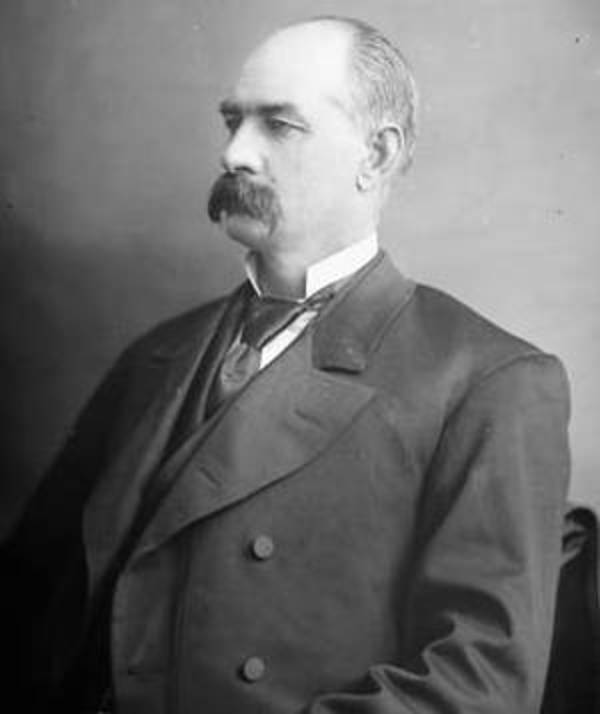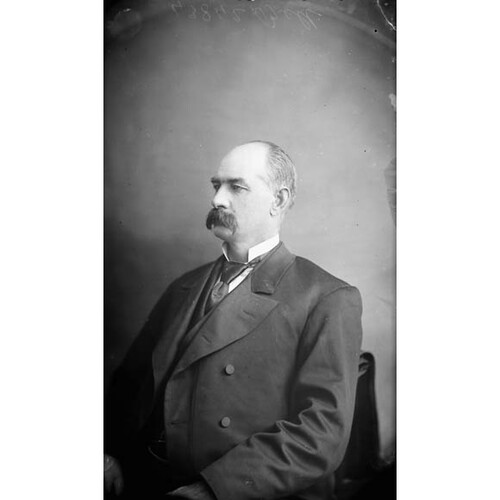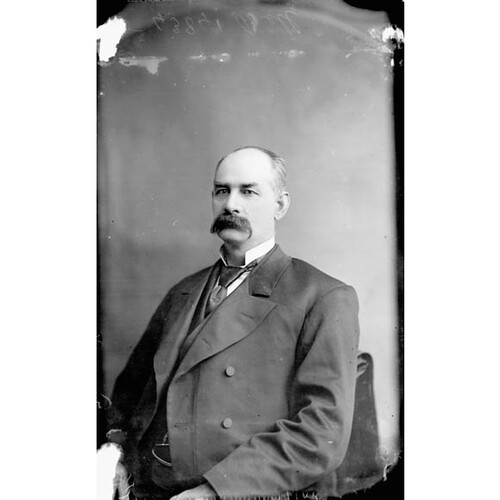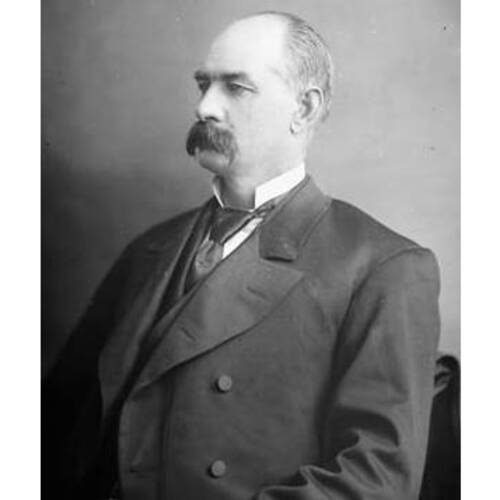
Source: Courtesy of Wikimedia Commons
BELL, JOHN WILLIAM, teacher, farmer, and politician; b. 18 March 1838 at Desmond, Lennox and Addington County, Upper Canada, eldest son of Daniel Fraser Bell and Christian (Chrisy) Mowbray; m. 4 Dec. 1869 Julia Purcell, and they had three sons and two daughters; d. 5 July 1901 on the family farm at Desmond.
John William Bell attended Newburgh Academy, not far from Desmond, and there he obtained a first-class teacher’s certificate. After teaching for ten years, he began farming on land adjoining his family’s property in Camden Township, which occupation he pursued until his death. An active Methodist and temperance advocate, he taught sabbath school and conducted a weekly Bible class. In municipal politics he served as a councillor in Camden (1872–73), reeve (1874–76, 1878–79, 1881), deputy reeve (1877), and warden of Lennox and Addington (1879). He served as warden during the investigation into a scandal surrounding county finances that led to the resignation in 1879 of county treasurer Edmund John Glyn Hooper*.
In 1882 Bell, a Conservative, entered federal politics as the member for Addington. Though re-elected in 1887, 1896, and 1900 (he lost in 1891), he was not an important mp, addressing the house on only three occasions. In addition to attending to the usual matters of patronage, he secured subsidies and line extensions for the Napanee, Tamworth and Quebec Railway, which ran through his constituency.
Bell experienced a moment of national prominence in March 1889, as one of the “noble thirteen” who supported William Edward O’Brien’s motion to disallow the Jesuits’ Estates Act [see D’Alton McCarthy*]. This Quebec legislation was particularly offensive to Ontario Orangemen because it authorized the pope to help adjudicate the settlement of the confiscated estates. Mass protest meetings swept Ontario; the Toronto Daily Mail [see Christopher William Bunting*] struck a medal commemorating the courage of the thirteen in defying their party caucuses. Bell’s letter to Prime Minister Sir John A. Macdonald* of 21 March, before the vote, explains his dilemma: “If I support the Government against . . . [the] motion . . . I shall be in a very awkward position with my Orange brethren . . . on whom I chiefly depend on rolling up my majority.” Bell had no reason for fear, however, for Macdonald had made it clear to O’Brien the previous day that there would be no retaliation against recalcitrant members. Indeed, the following month, he granted Bell another railway bonus.
In 1896 Bell once again distanced himself from his party when he ran for election as an “anti-remedialist,” despite official Conservative policy favouring remedial legislation restoring the school rights of Manitoba’s Catholics [see McCarthy]. On this occasion, too, little risk was involved, for almost half the Conservative candidates openly opposed such legislation. The danger for Bell lay in defying the district Orange lodge, which had pledged “to support no man” advocating a remedial law and which could draw 10,000 people to Napanee that summer to celebrate the “Glorious Twelfth.” Grand master, Ontario East (1895–97), at the lodge’s annual meeting in Picton in 1897 he set out his opposition to separate schools and remedial action. “It strikes me forcibly that when the clergy of any sect undertakes as a body to secure special legislation for their own advantage they manifest a greater desire to become masters of the earth than to secure an inheritance in heaven.”
In his last years Bell rose rapidly in the Orange order. He was elected vice-president of the Triennial Grand Orange Council of the World in Glasgow in 1897 and president of the World Council in New York City in 1900. He was not destined to complete his term, however. The Belleville Weekly Intelligencer proclaimed his sudden passing from a stroke in 1901 with the headline “World’s leading Orangeman dead.” An estimated 3,000 persons attended his funeral at Desmond, including 400 Orangemen from across Ontario and Quebec. Sir Mackenzie Bowel* and Nathaniel Clarke Wallace, both past presidents of the Triennial council and personal friends of Bell, spoke at his graveside.
The impressive funeral assemblage was a tribute to Bell’s immense personal popularity; his career was a reflection of the strength of the Orange order in rural Ontario in the late Victorian period.
[Several photographs of John William Bell are in the Lennox and Addington County Museum Library and Arch. (Napanee, Ont.). A photo also appears in K. F. Reid, “The life and career of John William Bell, M.P.,” Lennox and Addington Hist. Soc., Papers and Records (Napanee), 17 (1987): 42–54. This study was prepared in 1970 as a Grade XIII paper under the supervision of the present author. Bell’s diary, mentioned therein, has since been lost by his descendants. j.a.e.]
Lennox and Addington County Museum Library and Arch., Lennox and Addington Hist. Soc. Coll., T. W. Casey scrapbooks, J. W. Bell to Casey, 24 Sept. 1899. Loyal Orange Assoc. of British America Arch. (Toronto), Information on medal struck in 1889 commemorating opposition of the “noble thirteen” to the Jesuits’ Estates Act. NA, MG 26, A. Daily British Whig, 1882, 24 Jan. 1887, 1896. Napanee Beaver, 15 Oct. 1888; 20 Jan., 26 June, 17 July 1896; 1900; 1 June 1901; also a typescript copy, in the author’s possession, of T. W. Casey’s obituary tribute to Bell from the issue of 12 July 1901, which is no longer extant. Sentinel (Toronto), 25 March, 23 July 1897. Weekly Intelligencer (Belleville, Ont.), 11 July 1901. W. M. Alkenbrack, “The financial crisis in Lennox and Addington County, 1879–1880: the Hooper investigation,” Lennox and Addington Hist. Soc., Papers and Records, 14 (1972): 23–37. F. T. Bell and Mary Donovan, History of the Bell family, 1772–1960 (mimeograph, Centreville, Ont., n.d.; copy in Lennox and Addington County Museum). Can., House of Commons, Debates, 1883–84, 1886, 1889–90, 1897–98, 1900–1. L. C. Clark, “The Conservative party in the 1890’s,” CHA Report, 1961: 58–74. CPG, 1885, 1891. Grand Orange Lodge of British America, Report (Toronto), 1901. W. S. Herrington, History of the county of Lennox and Addington (Toronto, 1913; repr. Belleville, 1972). Lennox and Addington, County Council, Minutes (Napanee), 1863–85. J. F. O’Sullivan, “Dalton McCarthy and the Conservative party, 1876–1896” (ma thesis, Univ. of Toronto, 1949). Prov. Grand Orange Lodge of Ontario East, Report (Toronto), 1902.
Cite This Article
James A. Eadie, “BELL, JOHN WILLIAM,” in Dictionary of Canadian Biography, vol. 13, University of Toronto/Université Laval, 2003–, accessed January 17, 2026, https://www.biographi.ca/en/bio/bell_john_william_13E.html.
The citation above shows the format for footnotes and endnotes according to the Chicago manual of style (16th edition). Information to be used in other citation formats:
| Permalink: | https://www.biographi.ca/en/bio/bell_john_william_13E.html |
| Author of Article: | James A. Eadie |
| Title of Article: | BELL, JOHN WILLIAM |
| Publication Name: | Dictionary of Canadian Biography, vol. 13 |
| Publisher: | University of Toronto/Université Laval |
| Year of publication: | 1994 |
| Year of revision: | 1994 |
| Access Date: | January 17, 2026 |





